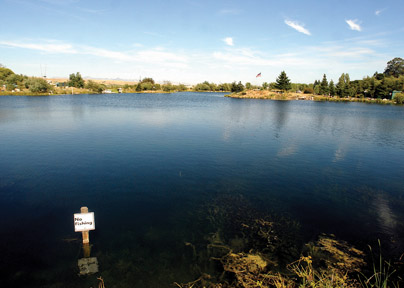Aromas residents Andy and Mary Hsia-Coron let a two-acre pond dry, stopped washing the car and changed to watering just plants that grow things they can eat.
“I imagine we use a lot less water then we did in previous years,” said Andy Hsia-Coron.
The Hsia-Corons share a well with two neighbors. It’s one of about 1,500 active wells in the San Benito County Water District’s zone six, which covers about 53,000 acres.
Gov. Jerry Brown’s new executive order requires municipalities to reduce water consumption by 25 percent from 2013 levels in an effort to deal with the statewide drought. None of the private well owners in the county will be affected by the changes.
“We can ask them to cut back on their uses the same amount,” said Shawn Novack, the program manager for the Water Resources Association of San Benito County. “Unfortunately, we can’t regulate a private well so it has to be done on an individual basis.”
The Hsia-Corons have yet to get a letter or email from a local water district or the state asking them to voluntarily cut their water use by 25 percent, he said. But for the couple, the dry pond that runs across their property and that of two neighbors is a good indicator of the times.
In the past, rain filled this water feature in the winter and, occasionally, the couple added to it during the summer. Back then, firemen were known to fly helicopters above the pond and dip buckets into the water so they could fight local flames. But now, the pond has shrunk to just a quarter-acre “puddle,” Hsia-Coron said.
“We let the pond dry up and let all the fish die actually,” he said. “We just couldn’t see pumping water out of the ground during a drought.”
California is in its fourth consecutive year of drought. This year brought an unusually warm, dry January and also marked the lowest snowpack ever recorded, according to the governor’s website.
Brown’s executive order implements a statewide appliance rebate program, prohibits the use of drinking water to irrigate grass on public street medians and sets an initiative to replace lawns, among other things.
“There really is no mechanism right now to police or to manage the water that comes out of private wells unless the basin is adjudicated,” said Jeff Cattaneo, the district manager of the San Benito County Water District.
Tres Pinos, San Juan Bautista and Hollister have water systems that operate off city wells or a combination of those and treated surface water from the San Benito County Water District, Cattaneo said. In more rural areas of the county such as Aromas, residents—including the Hsia-Corons—own private wells.
“We haven’t had any problems with our well at this point in terms of running dry but I know that there are other wells in the Aromas area that have had problems,” Andy Hsia-Coron said.
While water usage for private well owners isn’t restricted, Novack noted many are more “conscious” of the water levels than urbanites.
“A city dweller just turns on a faucet and that water magically appears,” he said.
Landscapes are a particularly large portion of city dwellers’ water usage, Novack said. Of residential water use, more than 50 percent goes toward keeping plants alive and much of that is wasted due to improperly scheduled irrigation times and faulty equipment, he said.
The executive order states the California Department of Water Resources will work with local agencies to lead a statewide initiative to replace 50 million square feet of lawns with drought tolerant landscapes.
The Water Resources Association of San Benito Countyalready runs the “Turf Removal Program” that started in July and offers $1 per square foot of grass up to $500. Since the program started, 35,000 square feet of lawns have been removed, Novack said.
The association also offers free water-efficient toilets to replace outdated appliances and advice on ways to cut water usage.There’s no crystal ball to see when the rains and snow will come, Novack said.
“The only thing we can do immediately to help out with the situation is conserve,” he said.
Agencies OK new rules
Hollister, San Juan, the county board and Sunnyslope water district passed resolutions this week establishing new rules related to the state’s mandatory water cutback of at least 25 percent.
As explained by Hollister City Manager Bill Avera on Monday for Hollister customers—as approved by council members—some of the restrictions include the following:
Customers are limited to landscaping from 9 a.m. to 5 p.m. two days a week—odd addresses on Tuesdays and Saturdays and even addresses on Wednesdays and Sundays.
Customers are limited to drip irrigation/quick release nozzles.
Water irrigation can’t occur on concrete.
If washing a vehicle, residents must use quick-release nozzles.
There is no operation of water fountains without a recycling mechanism.
New development landscaping is limited to drip or micro-spray.
Penalties include a warning on the first notice, a $100 fine the second, $250 the third and $500 on the fourth along with the requirement to install a flow restrictor.










